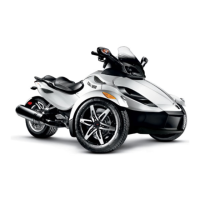REQUIRED RIDING SKILLS AND PRACTICE
EXERCISES
Before you take the Spyder roadster
on the road, you need to develop rid-
ing skills and strategies for managing
risk on the road. The following exer-
cises will familiarize you with the basic
operation of the vehicle. If you have
experience with motorcycles or other
motor vehicles, pay particular attention
to how the Spyder roadster operation
and performance are different from ve-
hicles you are used to. Practice each
exercise until you can perform it profi-
ciently before moving on to the next.
This section includes the following ex-
ercises:
SM5 Model
1. Revving the engine and using the
engine stop switch
2. Learning the friction zone and basic
handling
3. Engine stop while in motion
4. Using the throttle and clutch
5. Basic turns
6. Quick stops
7. Weaves
8. Shifting
9. Swerve
10.Operating in reverse.
SE5 Model
1. Revving the engine and using the
engine stop switch
2. Starting, stopping, and basic han-
dling
3. Engine stop while in motion
4. Basic turns
5. Quick stops
6. Weaves
7. Shifting
8. Swerve
9. Operating in reverse.
ChoosingaPracticeArea
Perform these exercises in a
paved area at least 76 m - 30 m
(250 ft - 100 ft) that is not open to traf-
fic. A closed, well marked parking lot
without obstacles (light poles, curbs,
etc.) makes a good practice area. Be
aware of oil left by parked cars. Look
for parking lots that are empty during
off hours, such as schools, churches,
community centers or shopping
centers. Do not trespass on private
property.
Onceyouhaveselectedasuitableloca-
tion, get permission to use it from the
owner. If there are obstructions, such
as light poles or islands, be sure that
they do not interfere with the required
open paths shown in the diagram be-
low.
Keep this basic parking lot diagram in
mind when setting up the exercises.
3 m (10 ft) wide parking lot spaces are
indicated in the diagrams for conve-
nience, but the size of the spaces in
the lot you use may be different. If the
parking lot you choose does not have
lines or if the parking spaces are sized
much larger or smaller than the ones
in the diagrams, use the dimensions
shown below. Mark them using a tape
measure and chalk or markers such
as cones or milk containers weighted
with water or sand.
______
SAFE OPERA
TING INSTRUCTIONS
______
41

